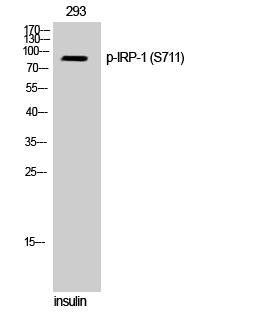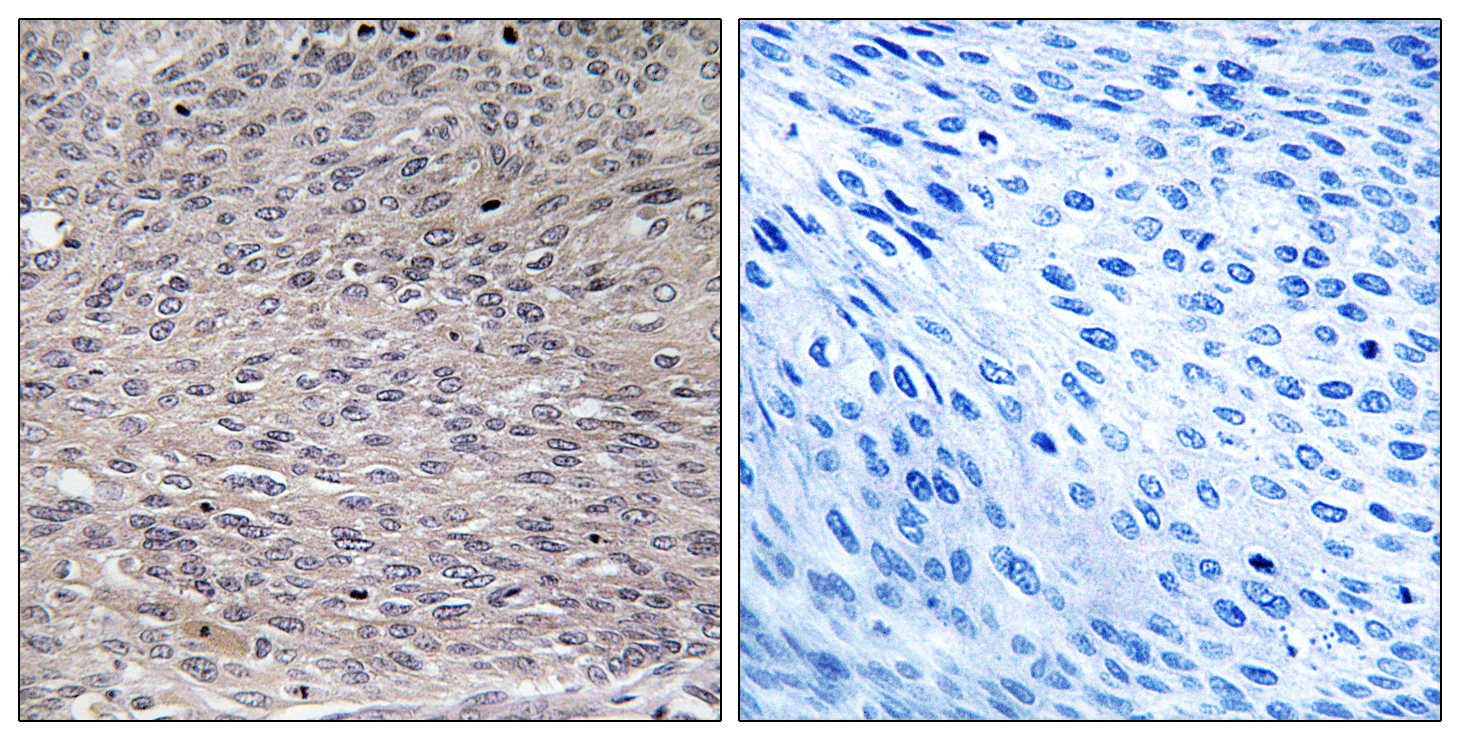IRP-1 (phospho Ser711) Polyclonal Antibody
- Catalog No.:YP0754
- Applications:WB;IHC;IF;ELISA
- Reactivity:Human;Mouse;Rat;Monkey
- Target:
- IRP-1
- Fields:
- >>Citrate cycle (TCA cycle);>>Glyoxylate and dicarboxylate metabolism;>>Metabolic pathways;>>Carbon metabolism;>>2-Oxocarboxylic acid metabolism;>>Biosynthesis of amino acids
- Gene Name:
- ACO1
- Protein Name:
- Cytoplasmic aconitate hydratase
- Human Gene Id:
- 48
- Human Swiss Prot No:
- P21399
- Mouse Gene Id:
- 11428
- Mouse Swiss Prot No:
- P28271
- Rat Gene Id:
- 50655
- Rat Swiss Prot No:
- Q63270
- Immunogen:
- The antiserum was produced against synthesized peptide derived from human IREB1 around the phosphorylation site of Ser711. AA range:681-730
- Specificity:
- Phospho-IRP-1 (S711) Polyclonal Antibody detects endogenous levels of IRP-1 protein only when phosphorylated at S711.
- Formulation:
- Liquid in PBS containing 50% glycerol, 0.5% BSA and 0.02% sodium azide.
- Source:
- Polyclonal, Rabbit,IgG
- Dilution:
- WB 1:500 - 1:2000. IHC 1:100 - 1:300. ELISA: 1:10000.. IF 1:50-200
- Purification:
- The antibody was affinity-purified from rabbit antiserum by affinity-chromatography using epitope-specific immunogen.
- Concentration:
- 1 mg/ml
- Storage Stability:
- -15°C to -25°C/1 year(Do not lower than -25°C)
- Other Name:
- ACO1;IREB1;Cytoplasmic aconitate hydratase;Aconitase;Citrate hydro-lyase;Ferritin repressor protein;Iron regulatory protein 1;IRP1;Iron-responsive element-binding protein 1;IRE-BP 1
- Observed Band(KD):
- 85kD
- Background:
- The protein encoded by this gene is a bifunctional, cytosolic protein that functions as an essential enzyme in the TCA cycle and interacts with mRNA to control the levels of iron inside cells. When cellular iron levels are high, this protein binds to a 4Fe-4S cluster and functions as an aconitase. Aconitases are iron-sulfur proteins that function to catalyze the conversion of citrate to isocitrate. When cellular iron levels are low, the protein binds to iron-responsive elements (IREs), which are stem-loop structures found in the 5' UTR of ferritin mRNA, and in the 3' UTR of transferrin receptor mRNA. When the protein binds to IRE, it results in repression of translation of ferritin mRNA, and inhibition of degradation of the otherwise rapidly degraded transferrin receptor mRNA. The encoded protein has been identified as a moonlighting protein based on its ability to perform mechanistically distinct
- Function:
- catalytic activity:Citrate = isocitrate.,cofactor:Binds 1 4Fe-4S cluster per subunit.,function:Binds to iron-responsive elements (IRES), which are stem-loop structures found in the 5'-UTR of ferritin, and delta aminolevulinic acid synthase mRNAs, and in the 3'-UTR of transferrin receptor mRNA. Binding to the IRE element in ferritin results in the repression of its mRNA translation. Binding of the protein to the transferrin receptor mRNA inhibits the degradation of this otherwise rapidly degraded mRNA. This protein also expresses aconitase activity.,online information:Aconitase entry,similarity:Belongs to the aconitase/IPM isomerase family.,
- Subcellular Location:
- Cytoplasm, cytosol .
- Expression:
- Brain,Brain astrocytoma,Uterus,
- June 19-2018
- WESTERN IMMUNOBLOTTING PROTOCOL
- June 19-2018
- IMMUNOHISTOCHEMISTRY-PARAFFIN PROTOCOL
- June 19-2018
- IMMUNOFLUORESCENCE PROTOCOL
- September 08-2020
- FLOW-CYTOMEYRT-PROTOCOL
- May 20-2022
- Cell-Based ELISA│解您多样本WB检测之困扰
- July 13-2018
- CELL-BASED-ELISA-PROTOCOL-FOR-ACETYL-PROTEIN
- July 13-2018
- CELL-BASED-ELISA-PROTOCOL-FOR-PHOSPHO-PROTEIN
- July 13-2018
- Antibody-FAQs
- Products Images

- Western Blot analysis of 293 cells using Phospho-IRP-1 (S711) Polyclonal Antibody

- Enzyme-Linked Immunosorbent Assay (Phospho-ELISA) for Immunogen Phosphopeptide (Phospho-left) and Non-Phosphopeptide (Phospho-right), using IREB1 (Phospho-Ser711) Antibody

- Immunohistochemistry analysis of paraffin-embedded human thyroid gland, using IREB1 (Phospho-Ser711) Antibody. The picture on the right is blocked with the phospho peptide.

- Western blot analysis of lysates from 293 cells treated with insulin 0.01U/ml 30', using IREB1 (Phospho-Ser711) Antibody. The lane on the right is blocked with the phospho peptide.



